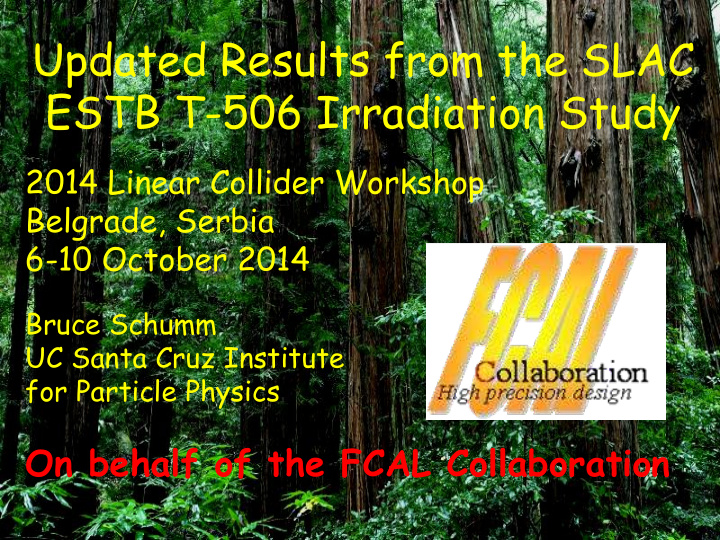



Updated Results from the SLAC ESTB T-506 Irradiation Study 2014 Linear Collider Workshop Belgrade, Serbia 6-10 October 2014 Bruce Schumm UC Santa Cruz Institute for Particle Physics On behalf of the FCAL Collaboration
T-506 Motivation BeamCal maximum dose ~100 MRad/yr BeamCal is sizable: ~2 m 2 of sensors. A number of ongoing studies with novel sensers: GaAs, CVD diamond Are these radiation tolerant? Also, might mainstream Si sensors be of use? Some reasons for optimism for Si… 2
Departure from NIEL (non-ionizing energy-loss) scaling observed for electron irradiation e - Energy NIEL 2x10 -2 0.5 MeV 5x10 -2 2 MeV 1x10 -1 10 MeV 2x10 -1 200 MeV G.P. Summers et al., IEEE Trans Nucl Sci 40 , 1372 (1993) Also: for ~50 MRad illumination of 900 MeV electrons, little loss of charge collection seen for wide variety of sensors [ S. Dittongo et al., NIM A 530, 110 (2004)] But what about the hadronic component of EM shower? 3
Hadronic Processes in EM Showers There seem to be three main processes for generating hadrons in EM showers (all induced by photons ): • Nuclear (“giant dipole”) resonances Resonance at 10-20 MeV (~E critical ) • Photoproduction Threshold seems to be about 200 MeV • Nuclear Compton scattering Threshold at about 10 MeV; resonance at 340 MeV These are largely isotropic; must have most of hadronic component develop near sample 4
Irradiating the Sensors 5
LCLS and ESA Use pulsed magnets in the beam switchyard to send beam in ESA. Mauro Pivi SLAC, ESTB 2011 Workshop, Page 6
ESTB parameters Parameters ESA Energy 3.5-10.5 (for now) 15 GeV Repetition Rate 5 Hz Up to 10 Hz! 0.25 nC ≤ 0.15 nC Charge per pulse 0.35 nC Energy spread, s E /E 0.02% 100 m m Bunch length rms Emittance rms ( ge x ,ge y ) (4, 1) 10 -6 m-rad Spot size at waist ( s x,y ) < 10 m m Drift Space available for experimental 60 m apparatus Transverse space available for experimental 5 x 5 m apparatus
Daughter Board Assembly Pitch adapter, bonds Sensor 1 inch 8
2 X 0 pre-radiator; introduces a little divergence in shower Sensor sample Not shown: 4 X 0 and 8 X 0 radiators just before and after sensor
Detector Fluence Distribution (per incident e - ) For later charge Fluence (particles per cm 2 ) collection measurement, must have ~1cm 2 uniformly illuminated area Raster sensor across beam 1.0 2.0 3.0 10 Radius (cm)
Dose Rates (Including 1 cm 2 Rastering) Mean fluence per incident e - Confirmed with RADFET to within 10% Maximum dose rate (10.6 GeV; 10 Hz; 150 pC per pulse): 28 Mrad per hour 11
T506 Si Doses “P” = p - type “N” = n -type “F” = float zone “C” = Czochralski 12
T506 GaAs Doses New this year: GaAs pad sensors via Georgy Shelkov, JINR Dubna Irradiated with 5.7 and 21.0 Mrad doses of electromagnetically-induced showers Irradiation temperature 3 o C; samples held 13 and measured at -15 o C
Assessing the Radiation Damage 14
Daughter/Readout Board Assembly 15
Charge Collection Apparatus • Readout: 300 ns Sensor + FE ASIC DAQ FPGA with Ethernet 16
Charge Collection Measurement 2.3 MeV e - through sensor into scintillator Median Collected Charge Channel-over- Efficiency vs. threshold profile threshold 17
Results 18
Results: PF sensors Doses of 5 and 20 Mrad No annealing 19
Results: PC sensors Dose of 20 Mrad No annealing 20
Results: NF sensor for low dose Doses of 5 and 20 Mrad No annealing 21
Results: NF Sensor to 90 Mrad, Plus Annealing Study Dose of 90 Mrad Limited beneficial annealing to 90 o C (reverse annealing above 100 o C?) 22
Results: NC sensors Dose of 220 Mrad Incidental annealing ~15% charge loss at 300 ns shaping 23
GaAs Charge Collection after 5.7 Mrad Exposure GaAs Dose of 5.7 Mrad No annealing 15-20% charge loss at 300 ns shaping 24
Compare to Direct Electron Radiation Results (no EM Shower) Georgy Shelkov, JINR 1000 kGy = 100 Mrad kGy Roughly consistent with direct result 25
Summary and Conclusions • In midst of a program of study of radiation damage in a realistic EM shower environment • Have irradiated and studied several Si sensors to as much as 220 Mrad, and GaAs to 6 Mrad. • Si sensors show some promise to survive the BeamCal integrated dose • GaAs shows charge loss at 6 Mrad, but still need to do annealing studies • Will soon explore 21 Mrad GaAs sensor and do annealing studies on both GaAs sensors • Expect to run at higher fluence in 2015 26
Recommend
More recommend